Unconventional Dual Donor-Acceptor Topologies of Aromatic Rings in Amine-Based Polymeric Tetrahedral Zn(II) Compounds Involving Unusual Non-Covalent Contacts: Antiproliferative Evaluation and Theoretical Studies
Abstract
1. Introduction
2. Experimental Section
2.1. Materials and Methods
2.2. Syntheses
2.2.1. Synthesis of [Zn2Cl2(H2O)2(µ-4-AmBz)2]n (1)
2.2.2. Synthesis of [ZnCl2(µ-3-AmPy)2]n (2)
2.3. Crystallographic Data Collection and Refinement
2.4. Computational Methods
2.5. Cell Line and Drug Preparation
2.6. Cytotoxicity and Apoptosis Assays
2.7. Molecular Docking Simulation
3. Results
3.1. Syntheses and General Aspects
3.2. Crystal Structure Analysis
3.3. Spectral Studies
3.3.1. FT-IR Spectroscopy
3.3.2. Electronic Spectroscopy
3.3.3. 1H-NMR Spectroscopy
3.4. Thermogravimetric Analysis
3.5. Theoretical Studies
3.6. Cytotoxicity and Apoptosis Assays
3.7. Molecular Docking Simulation
4. Conclusions
Supplementary Materials
Author Contributions
Funding
Data Availability Statement
Conflicts of Interest
References
- Lustig, W.P.; Mukherjee, S.; Rudd, N.D.; Desai, A.V.; Li, J.; Ghosh, S.K. Metal-organic frameworks: Functional luminescent and photonic materials for sensing applications. Chem. Soc. Rev. 2017, 46, 3242–3285. [Google Scholar] [CrossRef] [PubMed]
- Dhakshinamoorthy, A.; Li, Z.; Garcia, H. Catalysis and photocatalysis by metal organic frameworks. Chem. Soc. Rev. 2018, 47, 8134–8172. [Google Scholar] [CrossRef] [PubMed]
- Marabello, D.; Antoniotti, P.; Benzi, P.; Canepa, C.; Mortati, L.; Sassi, M.P. Synthesis, structure and non-linear optical properties of new isostructural β-D-fructopyranose alkaline halide metal–organic frameworks: A theoretical and an experimental study. Acta Cryst. 2017, 73, 737–743. [Google Scholar] [CrossRef]
- Sun, Q.; Zhu, X.; Zhang, N.; Zhang, B.; Lu, J.; Liu, H. Auxiliary ligand-assisted structural variation of two Co(II) metal-organic frameworks: Syntheses, crystal structure and magnetic properties. Inorg. Chem. Commun. 2019, 99, 172–175. [Google Scholar] [CrossRef]
- Zhang, J.; Jia, D.; Humphrey, M.G.; Meng, S.; Zaworotko, M.J.; Cifuentes, M.P.; Zhang, C. Ammonium–crown ether supramolecular cation-templated assembly of an unprecedented hetero bicluster–metal coordination polymer with enhanced NLO properties. Chem. Commun. 2016, 52, 3797–3800. [Google Scholar] [CrossRef]
- Chiniforoshan, H.; Pourrahim, N.; Tabrizi, L.; Tavakol, H.; Sabzalian, M.R.; Notash, B. Syntheses, studies and crystal structure of new coordination polymers of mercury (II) with phenylcyanamide derivative ligands. Inorg. Chim. Acta 2014, 416, 85–92. [Google Scholar] [CrossRef]
- Janiak, C. Engineering coordination polymers towards applications. Dalton Trans. 2003, 12, 2781–2804. [Google Scholar] [CrossRef]
- Croitor, L.; Coropceanu, E.B.; Duca, G.; Siminel, A.V.; Fonari, M.S. Nine Mn(II), Zn(II) and Cd(II) mixed-ligand coordination networks with rigid dicarboxylate and pyridine-n-aldoxime ligands: Impact of the second ligand in the structures’ dimensionality and solvent capacity. Polyhedron 2017, 129, 9–21. [Google Scholar] [CrossRef]
- Yunxiang, L.; Yingtao, L.; Haiying, L.; Xiang, Z.; Honglai, L.; Weiliang, Z. Energetic effects between halogen bonds and anion-π or lone pair-π interactions: A theoretical study. J. Phys. Chem. 2012, 116, 2591–2597. [Google Scholar]
- Lehn, J.M.; Atwood, J.L.; Davies, J.E.D.; MacNicol, D.D.; Vogtle, F. Comprehensive Supramolecular Chemistry; Elsevier, Pergamon: Oxford, UK, 1996. [Google Scholar]
- Gogoi, A.; Saha, U.; Dutta, D.; Bhattacharyya, M.K. A Supramolecular Dimer of Two crystallographically independent Co(II) phthalate bipyridine complexes in one single crystal: Synthesis, crystal structure, and thermal studies. J. Struct. Chem. 2019, 60, 324–332. [Google Scholar] [CrossRef]
- Cook, S.A.; Borovik, A.S. Molecular designs for controlling the local environments around metal ions. Acc. Chem. Res. 2015, 48, 2407–2414. [Google Scholar] [CrossRef] [PubMed]
- Reedijk, J. Coordination chemistry beyond Werner: Interplay between hydrogen bonding and coordination. Chem. Soc. Rev. 2013, 42, 1776–1783. [Google Scholar] [CrossRef] [PubMed]
- Thakuria, R.; Nath, N.K.; Saha, B.K. The nature and applications of π–π interactions: A perspective. Cryst. Growth Des. 2019, 19, 523–528. [Google Scholar] [CrossRef]
- Bauzá, A.; Frontera, A. Theoretical Study on the Dual Behavior of XeO3 and XeF4 toward Aromatic Rings: Lone Pair–π versus Aerogen–π Interactions. ChemPhysChem 2015, 16, 3625–3630. [Google Scholar] [CrossRef] [PubMed]
- Bibi, S.; Zhang, J. The ratio and topology effects of benzodithiophene donor–benzooxadiazole acceptor fragments on the optoelectronic properties of donor molecules toward solar cell materials. Phys. Chem. Chem. Phys. 2015, 17, 7986–7999. [Google Scholar] [CrossRef]
- Ramasubbu, N.; Parthasarathy, R.; Murray-Rust, P. Angular preferences of intermolecular forces around halogen centers: Preferred directions of approach of electrophiles and nucleophiles around carbon-halogen bond. J. Am. Chem. Soc. 1986, 108, 4308–4314. [Google Scholar] [CrossRef]
- Piracha, N.K.; Ito, F.; Nakanaga, T. Infrared depletion spectroscopy of aniline–toluene cluster: The investigation of the red shifts of the NH2 stretching vibrations of aniline–aromatic clusters. Chem. Phys. 2004, 297, 133–138. [Google Scholar] [CrossRef]
- Chernova, E.F.; Ovsyannikov, A.S.; Solovieva, S.E.; Antipin, I.S.; Kyritsakas, N.; Hosseini, M.W.; Ferlay, S. Control of dimensionality in Manganese Coordination Polymers using rigid tetrahedral-shaped [1.1.1.1]metacyclophane ligands bearing benzoate coordinating sites: From homochiral 1D to 3D diamond-like structures. Inorg. Chem. Commun. 2019, 106, 197–201. [Google Scholar] [CrossRef]
- Zhao, N.; Li, Y.; Gu, J.; Fernandes, T.A.; Kirillova, M.V.; Kirillov, A.M. New copper(II) coordination compounds assembled from multifunctional pyridine-carboxylate blocks: Synthesis, structures, and catalytic activity in cycloalkane oxidation. Molecules 2019, 24, 6. [Google Scholar] [CrossRef]
- Khan, E. Pyridine derivatives as biologically active precursors; organics and selected coordination complexes. ChemistrySelect 2021, 6, 3041–3064. [Google Scholar] [CrossRef]
- Raj, D.; Padhi, S.K. The sporadic μ-pyridine bridge in transition metal complexes: A real bond or an interaction? Coord. Chem. Rev. 2022, 450, 214238–214245. [Google Scholar] [CrossRef]
- Posa, V.; Hajdu, B.; Tóth, G.; Domotor, O.; Kowol, C.R.; Keppler, B.K.; Spengler, G.; Gyurcsik, B.; Enyedy, E.A. The coordination modes of (thio) semicarbazone copper (II) complexes strongly modulate the solution chemical properties and mechanism of anticancer activity. J. Inorg. Biochem. 2022, 231, 111786–111792. [Google Scholar] [CrossRef] [PubMed]
- Sharma, P.; Reddy, P.K.; Kumar, B. Trace element zinc, a nature’s gift to fight unprecedented global pandemic COVID-19. Biol. Trace Elem. Res. 2021, 199, 3213–3221. [Google Scholar] [CrossRef] [PubMed]
- Ho, E. Zinc deficiency, DNA damage and cancer risk. J. Nutr. Biochem. 2004, 15, 572–578. [Google Scholar] [CrossRef]
- Prasad, A.S. Discovery of human zinc deficiency: 50 years later. J. Trace Elem. Med. Biol. 2012, 26, 66–69. [Google Scholar] [CrossRef]
- Phukan, N.; Baruah, J.B. Hydrolysis of 4-(4-oxopentan-2-ylideneamino) benzoic acid and in-situ formation of nickel (II), zinc (II) and cadmium (II) complexes of 4-aminobenzoic acid. Inorg. Chim. Acta 2013, 396, 430–435. [Google Scholar] [CrossRef]
- Dutta, D.; Islam, S.M.N.; Saha, U.; Chetry, S.; Guha, A.K.; Bhattacharyya, M.K. Structural topology of weak non-covalent interactions in a layered supramolecular coordination solid of zinc involving 3-aminopyridine and benzoate: Experimental and theoretical studies. J. Chem. Crystallogr. 2018, 48, 156–163. [Google Scholar] [CrossRef]
- Pahontu, E.; Ilies, D.; Shova, S.; Oprean, C.; Paunescu, V.; Olaru, O.T.; Radulescu, F.S.; Gulea, A.; Rosu, T.; Draganescu, D. Synthesis, characterization, antimicrobial and antiproliferative activity evaluation of Cu (II), Co (II), Zn (II), Ni (II) and Pt (II) complexes with isoniazid-derived compound. Molecules 2017, 22, 650. [Google Scholar] [CrossRef]
- Paria, D.; Kundu, S.; Singh, K.S. Synthesis, characterization and antidiabetic activity of some water soluble Zn (II) complexes with (E)-N-(Thiophen-2-ylmethylene) anilines. Asian J. Chem. 2018, 30, 1115–1119. [Google Scholar] [CrossRef]
- Psomas, G. Copper(II) and zinc(II) coordination compounds of non-steroidal anti-inflammatory drugs: Structural features and antioxidant activity. Coord. Chem. Rev. 2020, 412, 213259–213271. [Google Scholar] [CrossRef]
- Akter, J.; Hanif, M.A.; Banu, L.A. Synthesis, characterization and antimicrobial activity of zinc(II) ibuprofen complexes with nitrogen-based ligands. J. Coord. Chem. 2016, 69, 1110–1122. [Google Scholar]
- Dhaveethu, K.; Ramachandramoorthy, T.; Thirunavukkarasu, K. Spectroscopic, Thermal and Biological Studies of Zn(II), Cd(II) and Hg(II) Complexes Derived from 3-Aminopyridine and Nitrite Ion. J. Korean Chem. Soc. 2013, 57, 712–720. [Google Scholar] [CrossRef]
- Koczoń, P. Growth Inhibition Mode of Action of Selected Benzoic Acid Derivatives against the Yeast Pichia anomala. J. Food Prot. 2009, 72, 791–800. [Google Scholar] [CrossRef] [PubMed]
- Devrim, A.K.; Arslantas, A.; Kayat, N.; Necefoglu, H. An investigation on the effects of a zinc complex on gooses genomic DNA. Asian J. Chem. 2008, 20, 5827–5833. [Google Scholar]
- Tarushi, A.; Kakoulidou, C.; Raptopoulou, C.P.; Psycharis, V.; Kessissoglou, D.P.; Zoi, I.; Papadopoulos, A.N.; Psomas, G. Zinc complexes of diflunisal: Synthesis, characterization, structure, antioxidant activity, and in vitro and in silico study of the interaction with DNA and albumins. J. Inorg. Biochem. 2017, 170, 85–97. [Google Scholar] [CrossRef] [PubMed]
- Ferrada, E.; Arancibia, V.; Loeb, B.; Norambuena, E.; Olea-Azarand, C.; Huidobro-Toro, J.P. Stoichiometry and conditional stability constants of Cu (II) or Zn (II) clioquinol complexes; implications for Alzheimer’s and Huntington’s disease therapy. Neurotoxicology 2007, 28, 445–449. [Google Scholar] [CrossRef]
- Verma, P.K.; Singh, R.K.; Kumar, S.; Shukla, A.; Kumar, S.; Gond, M.K.; Bharty, M.K.; Acharya, A. Cobalt (III) complex exerts anti-cancer effects on T cell lymphoma through induction of cell cycle arrest and promotion of apoptosis. J. Pharm. Sci. 2022, 30, 127–138. [Google Scholar] [CrossRef]
- Priya, N.P.; Firdous, A.P.; Jeevana, R.; Aravindakshan, K.K. Cytotoxic and Antitumour Studies of Acetoacetanilide N(4)-methyl(phenyl)thiosemicarbazone and its Transition Metal Complexes. Indian J. Pharm. Sci. 2015, 77, 655–660. [Google Scholar]
- Jayendran, M.; Kurup, M.R.P. Structural, spectral, cytotoxic and biocatalytic studies of a dinuclearphenoxo bridged Zn (II) complex from NNO donor tridentate Schiff base. Chem. Data Collect. 2022, 39, 100853–100863. [Google Scholar] [CrossRef]
- APEX3, SAINT, SADABS and XP; Bruker AXS Inc.: Madison, WI, USA, 2015.
- Sheldrick, G.M. Crystal structure refinement with SHELXL. Acta Crystallogr. Sect. A Found. Crystallogr. 2008, 64, 112–122. [Google Scholar] [CrossRef]
- Farrugia, L.J. WinGX and ORTEP for Windows: An update. J. Appl. Crystallogr. 1999, 32, 837–838. [Google Scholar] [CrossRef]
- Spek, A.L. Structure validation in chemical crystallography. Acta Crystallogr. Sect. D Biol. Crystallogr. 2009, 65, 148–155. [Google Scholar] [CrossRef]
- Macrae, C.F.; Bruno, I.J.; Chisholm, J.A.; Edgington, P.R.; McCabe, P.; Pidcock, E.; Rodriguez-Monge, L.; Taylor, R.; Streek, J.; Wood, P.A. Mercury CSD 2.0–new features for the visualization and investigation of crystal structures. J. Appl. Crystallogr. 2008, 41, 466–470. [Google Scholar] [CrossRef]
- Brandenburg, K. Diamond 3.1f; Crystal Impact GbR: Bonn, Germany, 2008. [Google Scholar]
- Grimme, S.; Antony, J.; Ehrlich, S.; Krieg, H. A consistent and accurate ab initio parametrization of density functional dispersion correction (DFT-D) for the 94 elements H-Pu. J. Chem. Phys. 2010, 132, 154104–154119. [Google Scholar] [CrossRef] [PubMed]
- Weigend, F. Accurate Coulomb-fitting basis sets for H to Rn. Phys. Chem. Chem. Phys. 2006, 8, 1057–1065. [Google Scholar] [CrossRef]
- Ahlrichs, R.; Bar, M.; Hacer, M.; Horn, H.; Kömel, C. Electronic structure calculations on workstation computers: The program system turbomole. Chem. Phys. Lett. 1989, 162, 165–169. [Google Scholar] [CrossRef]
- Contreras-Garcia, J.; Johnson, E.R.; Keinan, S.; Chaudret, R.; Piquemal, J.P.; Beratan, D.N.; Yang, W. NCIPLOT: A program for plotting non-covalent interaction regions. J. Chem. Theory Comput. 2011, 7, 625–632. [Google Scholar] [CrossRef]
- Bader, R.F.W. Atoms in molecules. Chem. Rev. 1991, 91, 893–928. [Google Scholar] [CrossRef]
- Lu, T.; Chen, F. Multiwfn: A multifunctional wavefunction analyzer. J. Comput. Chem. 2012, 33, 580–592. [Google Scholar] [CrossRef]
- Humphrey, J.W.; Dalke, A.; Schulten, K. VMD: Visual molecular dynamics. J. Mol. Graph. 1996, 14, 33–38. [Google Scholar] [CrossRef]
- Klein, G. Comparative studies of mouse tumors with respect to their capacity for growth as “ascites tumors” and their average nucleic acid content per cell. Exp. Cell Res. 1951, 2, 518–524. [Google Scholar] [CrossRef]
- Sriram, M.I.; Kanth, S.B.M.; Kalishwaralal, K.; Gurunathan, S. Antitumor activity of silver nanoparticles in Dalton’s lymphoma ascites tumor model. Int. J. Nanomed. 2010, 5, 753–762. [Google Scholar]
- Pourahmad, J.; Salimi, A. Isolated human peripheral blood mononuclear cell (PBMC), a cost effective tool for predicting immunosuppressive effects of drugs and xenobiotics. Iran J. Pharm. Res. 2015, 14, 979–983. [Google Scholar] [PubMed]
- Strober, W. Trypan blue exclusion test of cell viability. Curr. Prot. Immunol. 2015, 111, 3–12. [Google Scholar] [CrossRef] [PubMed]
- Avelar-Freitas, B.A.; Almeida, V.G.; Pinto, M.C.X.; Mourão, F.A.G.; Massensini, A.R.; Martins-Filho, O.A.; Rocha-Vieira, E.; Brito-Melo, G.E.A. Trypan blue exclusion assay by flow cytometry. Braz. J. Med. Biol. Res. 2014, 47, 307–315. [Google Scholar] [CrossRef]
- Verma, A.K.; Prasad, S.B. Changes in Glutathione, Oxidative Stress and Mitochondrial Membrane Potential in Apoptosis Involving the Anticancer Activity of Cantharidin Isolated from Redheaded Blister Beetles, Epicautahirticornis. Anti-Cancer Agents Med. Chem. 2013, 13, 1096–1114. [Google Scholar] [CrossRef]
- Verma, A.K.; Singh, S. Phytochemical analysis and in vitro cytostatic potential of ethnopharmacological important medicinal plants. Toxicol. Rep. 2020, 7, 443–452. [Google Scholar] [CrossRef]
- Berry, M.; Fielding, B.; Gamieldien, J. Practical considerations in virtual screening and Molecular docking. Emer. Trends Comput. Biol. 2015, 45, 487–502. [Google Scholar]
- Frenzel, A.; Grespi, F.; Chmelewskij, W.; Villunger, A. Bcl2 family proteins in carcinogenesis and the treatment of cancer. Apoptosis 2009, 14, 584–596. [Google Scholar] [CrossRef]
- Thomsen, R.; Christensen, M.H. MolDock: A new technique for high-accuracy molecular docking. J. Med. Chem. 2006, 49, 3315–3321. [Google Scholar] [CrossRef]
- Soderquist, R.S.; Eastman, A. BCL2 Inhibitors as Anticancer Drugs: A Plethora of Misleading BH3 Mimetics BCL2 Inhibitors as Anticancer Agents. Mol. Cancer Ther. 2016, 15, 2011–2017. [Google Scholar] [CrossRef]
- Alexandra, B. CCDC 1852819. CSD Commun. 2018. [Google Scholar] [CrossRef]
- Goher, M.A.S.; Abu-Youssef, M.A.M.; Mautner, F.A. Synthesis, spectral and structural characterization of a monomeric chloro complex of zinc (II) with picolinic acid, [Zn (C5H4NCO2H)(C5H4NCO2)Cl]. Polyhedron 1996, 15, 453–457. [Google Scholar] [CrossRef]
- Jin, S.; Wang, D.; Wang, X.; Guo, M.; Zhao, Q. Structural characterization of a Cu(I) coordination polymer constructed by weak intermolecular Cu–Cl⋯ Cl–Ar interaction. J. Inorg. Organomet. Polym. Mater. 2008, 18, 300–303. [Google Scholar] [CrossRef]
- Cavallo, G.; Metrangolo, P.; Milani, R.; Pilati, T.; Priimagi, A.; Resnati, G.; Terraneo, G. The halogen bond. Chem. Rev. 2016, 116, 2478–2601. [Google Scholar] [CrossRef] [PubMed]
- Li, J.; Du, Z.; Pan, Q.; Zhang, L.; Liu, D. The first 3, 5, 6-trichloropyridine-2-oxyacetate bridged manganese coordination polymer with features of π⋯π stacking and halogen⋯halogen interactions: Synthesis, crystal analysis and magnetic properties. Inorg. Chim. Acta 2020, 509, 119677–119688. [Google Scholar] [CrossRef]
- Dojer, B.; Pevec, A.; Belaj, F.; Kristl, M. Two new zinc (II) acetates with 3–and 4–aminopyridine: Syntheses and structural properties. Acta Chim. Slov. 2015, 62, 312–318. [Google Scholar] [CrossRef] [PubMed]
- Zhou, C.; Zhua, H.; Wang, Y.; Liu, P.; Zhou, L.; Li, D.; Shi, Q. Novel supramolecular structures and theoretical calculation of Ag(I) and Zn(II) complexes based on a new dipyridylamine ligand. J. Mol. Struct. 2005, 779, 61–67. [Google Scholar] [CrossRef]
- Yaghoubi, A.; Khazaei, M.; Ghazvini, K.; Movaqar, A.; Avan, A.; Hasanian, S.M.; Soleimanpour, S. Peptides with Dual Antimicrobial-Anticancer Activity Derived from the N-terminal Region of H. pylori Ribosomal Protein L1 (RpL1). Int. J. Peptide Res. Ther. 2021, 27, 1057–1067. [Google Scholar] [CrossRef]
- Pedrosa, P.; Carvalho, A.; Baptista, P.V.; Fernandes, A.R. Basic Concepts Viewed from Frontier in Inorganic Coordination Chemistry; Wiley-VCH: Weinheim, Germany, 2018. [Google Scholar]
- Wang, Y.; Lin, X.M.; Bai, F.Y.; Sun, L.X. Novel vanadium complexes with rigid carboxylate ligands: Synthesis, structure and catalytic bromine dynamics of phenol red. J. Mol. Struct. 2017, 1149, 379–386. [Google Scholar] [CrossRef]
- Sharma, R.P.; Saini, A.; Kumar, J.; Kumar, S.; Venugopalan, P.; Ferretti, V. Coordination complexes of copper(II) with herbicide-trichlorophenoxyacetate: Syntheses, characterization, single crystal X-ray structure and packing analyses of monomeric [Cu(γ-pic)3(2,4,5-trichlorophenoxyacetate)]·H2O, [trans-Cu(en)2(2,4,5-trichlorophenoxyacetate)2]·2H2O and dimeric [Cu2(H2tea)2(2,4,5-trichlorophenoxyacetate)2]·2(H2O). Inorg. Chim. Acta 2017, 457, 59–68. [Google Scholar]
- Diab, M.A.; Mohamed, G.G.; Mahmoud, W.H.; El-Sonbati, A.Z.; Morgan, S.M.; Abbas, S.Y. Metal-and covalent organic frameworks as catalyst for organic transformation: Comparative overview and future perspectives. Appl. Organomet. Chem. 2019, 33, 4945–4965. [Google Scholar]
- Deacon, G.B.; Phillips, R.J. Relationships between the carbon-oxygen stretching frequencies of carboxylato complexes and the type of carboxylate coordination. Coord. Chem. Rev. 1980, 33, 227–250. [Google Scholar] [CrossRef]
- Alves, S.R.; Santos, R.L.; Fornaciari, L.B.; Colquhoun, A.; Oliveira, D.S. A novel μ-oxo-diruthenium(III,III)-ibuprofen-(4-aminopyridine) chloride derived from the diruthenium(II,III)-ibuprofen paddlewheel metallodrug shows anticancer properties. J. Inorg. Biochem. 2021, 225, 111596. [Google Scholar] [CrossRef]
- Araujo, E.L.; Barbosa, H.F.G.; Dockal, E.R.; Cavalheiro, E.T.G. Synthesis, characterization and biological activity of Cu(II), Ni(II) and Zn(II) complexes of biopolymeric Schiff bases of salicylaldehydes and chitosan. Int. J. Biol. Macromol. 2017, 95, 168–176. [Google Scholar] [CrossRef] [PubMed]
- Sharma, R.P.; Sharma, R.; Bala, R.; Venugopalan, P. Synthesis, spectroscopic and X-ray structural study of [trans-di (4-aminobenzoato) bis (ethylenediamine) cobalt (III)] 4-aminobenzoate tetrahydrate. J. Chem. Crystallogr. 2005, 35, 595–601. [Google Scholar] [CrossRef]
- Koleva, B.B.; Trendafilova, E.N.; Arnaudov, M.G. Spectral analysis and crystal structure of a new mononuclear copper (II) complex of 3-aminopyridine. Transit. Met. Chem. 2006, 31, 866–873. [Google Scholar] [CrossRef]
- Bonhomme, F.; Alam, T.M.; Celestian, A.J.; Tallant, D.R.; Boyle, T.J.; Cherry, B.R.; Tissot, R.G.; Rodriguez, M.A.; Parise, J.B.; Nyman, M. Tribasic lead maleate and lead maleate: Synthesis and structural and spectroscopic characterizations. Inorg. Chem. 2005, 44, 7394–7402. [Google Scholar] [CrossRef]
- Al-Azab, F.M.; Jamil, Y.M.S.; Maqtari, M.A.A.; Al Qadasy, M.K. Synthesis, characterization and biological activity of mixed transition metal complexes of pyrimethamine with 1, 10-phenanthroline. J. Modern Sci. Eng. 2017, 1, 9–21. [Google Scholar]
- Mchiri, C.; Edziri, H.; Hajji, H.; Bouachrine, M.; Acherar, S.; Frochot, C.; Eldine, H.O.B.; Moussa, S.B.; Nasri, H. Microwave assisted synthesis and characterizations of zn (ii) metal complex with bio-active isoniazid and benzoate ions. J. Chem. Sci. 2022, 134, 22–44. [Google Scholar] [CrossRef]
- Rosales-Vázquez, L.D.; Valdes-Garcia, J.; Bazany-Rodriguez, I.J.; Germán-Acacio, J.M.; Martínez-Otero, D.; Vilchis-Néstor, F.; Morales-Luckie, R.; Sánchez-Mendieta, V.; Dorazco-González, A. A sensitive photoluminescentchemosensor for cyanide in water based on a zinc coordination polymer bearing ditert-butyl-bipyridine. Dalton Trans. 2019, 48, 12407–12420. [Google Scholar] [CrossRef] [PubMed]
- Bora, S.J.; Das, B.K. Synthesis, structure and properties of a fumarate bridged Ni (II) coordination polymer. J. Mol. Struct. 2011, 999, 83–88. [Google Scholar] [CrossRef]
- Bhattacharyya, M.K.; Gogoi, A.; Chetry, S.; Dutta, D.; Verma, A.K.; Sarma, B.; Franconetti, A.; Frontera, A. Antiproliferative evaluation and supramolecular association in Mn (II) and Zn (II) bipyridine complexes: Combined experimental and theoretical studies. J. Inorg. Biochem. 2019, 200, 110803–110813. [Google Scholar] [CrossRef] [PubMed]
- Yang, Q.; Chen, S.; Gao, S. Two Mn (II) chloride complexes containing guest molecules. J. Therm. Anal. Calorim. 2007, 89, 567–571. [Google Scholar] [CrossRef]
- Goher, M.A.; Hafez, A.K.; Abu-Youssef, M.A.M.; Badr, A.M.A.; Gspan, C.; Mautner, F.A. New metal (II) complexes containing monodentate and bridging 3-aminopyridine and azido ligands. Polyhedron 2004, 23, 2349–2356. [Google Scholar] [CrossRef]
- Espinosa, E.; Molins, E.; Lecomte, C. Hydrogen bond strengths revealed by topological analyses of experimentally observed electron densities. Chem. Phys. Lett. 1998, 285, 170–173. [Google Scholar] [CrossRef]
- Ibrahim, M.A.A.; Saeed, R.A.A.; Shehata, M.N.I.; Ahmed, M.N.; Shawky, A.M.; Khowdiary, M.M.; Elkaeed, E.B.; Soliman, M.E.S.; Moussa, N.A.M. Autophagy-mediated regulation of different meristems in plants. Int. J. Mol. Sci. 2022, 23, 3114. [Google Scholar] [CrossRef]
- Tennant, J.R. Evaluation of the trypan blue technique for determination of cell viability. Transplantation 1964, 2, 685–694. [Google Scholar] [CrossRef]
- Altman, S.A.; Randers, L.; Rao, G. Comparison of trypan blue dye exclusion and fluorometric assays for mammalian cell viability determinations. Biotechnol. Progr. 1993, 9, 671–674. [Google Scholar] [CrossRef]
- Illán-Cabeza, N.A.; Hueso-Urena, F.; Moreno-Carretero, M.N.; Martínez-Martos, J.M.; Ramírez-Expósito, M.J. Synthesis, characterization and antiproliferative activity of metal complexes with the Schiff base derived from the condensation 1:2 of 2,6-diformyl-4-methylphenol and 5,6-diamino-1,3-dimethyluracil. J. Inorg. Biochem. 2008, 102, 647–655. [Google Scholar] [CrossRef]
- Alalawy, M.D.; Patel, U.H.; Bhatt, B.S.; Patel, N.J. Exploring qualitative and quantitative contributions of intermolecular interactions, DNA-binding and in vitro cytotoxic activity of isostructural and isomorphous Cd and Zn complexes. Polyhedron 2020, 185, 114595–114608. [Google Scholar] [CrossRef]
- Nath, H.; Dutta, D.; Sharma, P.; Frontera, A.; Verma, A.K.; Barceló-Oliver, M.; Devi, M.; Bhattacharyya, M.K. Adipato bridged novel hexanuclear Cu(ii) and polymeric Co(ii) coordination compounds involving cooperative supramolecular assemblies and encapsulated guest water clusters in a square grid host: Antiproliferative evaluation and theoretical studies. Dalton Trans. 2020, 49, 9863–9881. [Google Scholar] [CrossRef] [PubMed]
- Garcia-Valdivia, A.A.; Cepeda, J.; Fernandez, B.; Medina-O’donnell, M.; Oyarzabal, I.; Parra, J.; Jannus, F.; Choquesillo-Lazarte, D.; García, J.A.; Lupiáñez, J.A.; et al. 5-Aminopyridine-2-carboxylic acid as appropriate ligand for constructing coordination polymers with luminescence, slow magnetic relaxation and anti-cancer properties. J. Inorg. Biochem. 2020, 207, 11105–11125. [Google Scholar] [CrossRef] [PubMed]
- Cui, Z.; Liu, H.; Yuan, Y.; Wang, X.; Tang, J.; Chu, P.; Zhang, Y. Two novel nanostructured La(III) coordination polymers were synthesized by sonochemical: Crystal structures along with anticancer activity on human nasopharyngeal carcinoma cells. J. Iran. Chem. Soc. 2020, 17, 2307–2316. [Google Scholar] [CrossRef]
- Li, W.; Chen, X. Sulphated alumina tungstic acid (SATA): A highly efficient and novel heterogeneous mesostructured catalyst for the synthesis of pyrazolecarbonitrile derivatives and evaluation of green metrics. Inorg. Nano-Met. Chem. 2017, 47, 1682–1685. [Google Scholar] [CrossRef]
- Das, A.; Sharma, P.; Gomila, R.M.; Frontera, A.; Verma, A.K.; Sarma, B.; Bhattacharyya, M.K. Synthesis, structural topologies and anticancer evaluation of phenanthroline-based 2, 6-pyridinedicarboxylato Cu (II) and Ni (II) compounds. Polyhedron 2021, 45, 115632–115641. [Google Scholar] [CrossRef]
- D’Aguanno, S.; Bufalo, D.D. Inhibition of anti-apoptotic Bcl-2 proteins in preclinical and clinical studies: Current overview in cancer. Cells 2020, 9, 1287. [Google Scholar] [CrossRef]
- Meng, X.Y.; Zhang, H.X.; Mezei, M.; Cui, M. Molecular docking: A powerful approach for structure-based drug discovery. Curr. Comput. Aided Drug Des. 2011, 7, 146–157. [Google Scholar] [CrossRef]
- Adams, J.M.; Cory, S. The Bcl-2 apoptotic switch in cancer development and therapy. Oncogene 2007, 26, 1324–1337. [Google Scholar] [CrossRef]
- Harris, M.H.; Thompson, C.B. The role of the Bcl-2 family in the regulation of outer mitochondrial membrane permeability. Cell Death Differ. 2000, 7, 1182–1191. [Google Scholar] [CrossRef]
- Bruncko, M. Studies leading to potent, dual inhibitors of Bcl-2 and Bcl-Xl. J. Med. Chem. 2007, 50, 641–662. [Google Scholar] [CrossRef] [PubMed]
- Jain, A.N. Scoring functions for protein-ligand docking. Curr. Protein Peptide Sci. 2006, 7, 407–420. [Google Scholar]
- Konakanchi, R.; Pamidimalla, G.S.; Prashanth, J.; Naveen, T.; Kotha, L.R. Structural elucidation, theoretical investigation, biological screening and molecular docking studies of metal(II) complexes of NN donor ligand derived from 4-(2-aminopyridin-3-methylene)aminobenzoic acid. BioMetals 2021, 34, 529–556. [Google Scholar] [CrossRef] [PubMed]
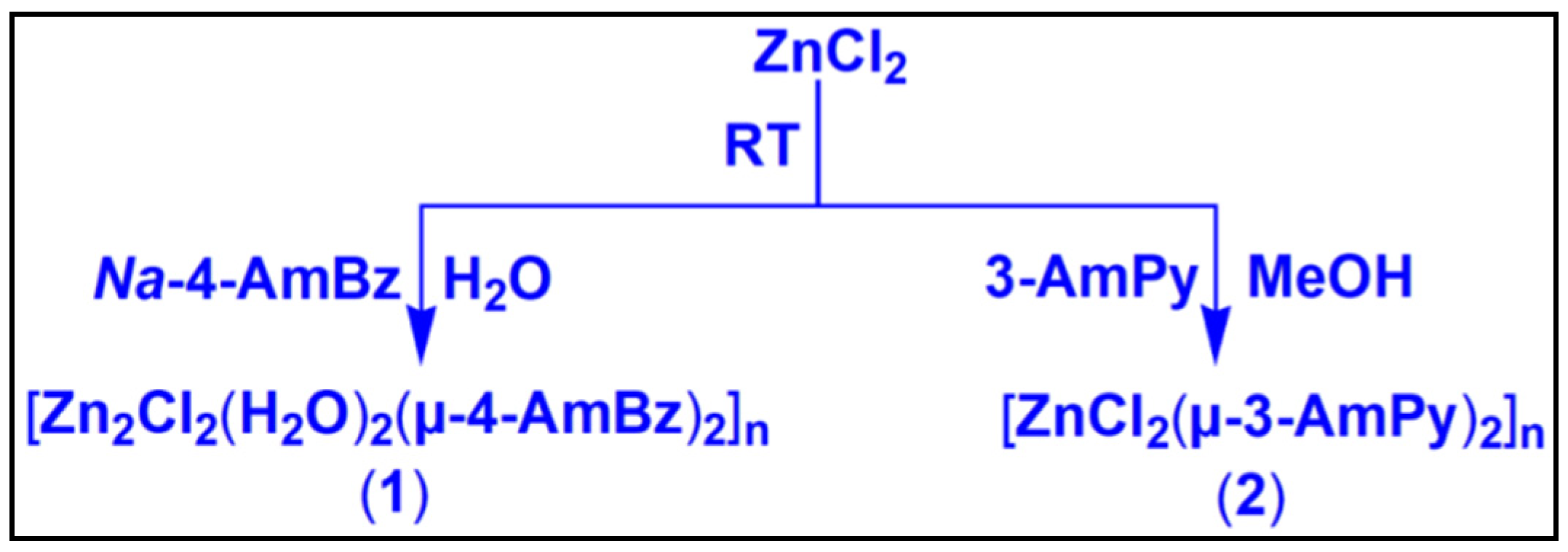

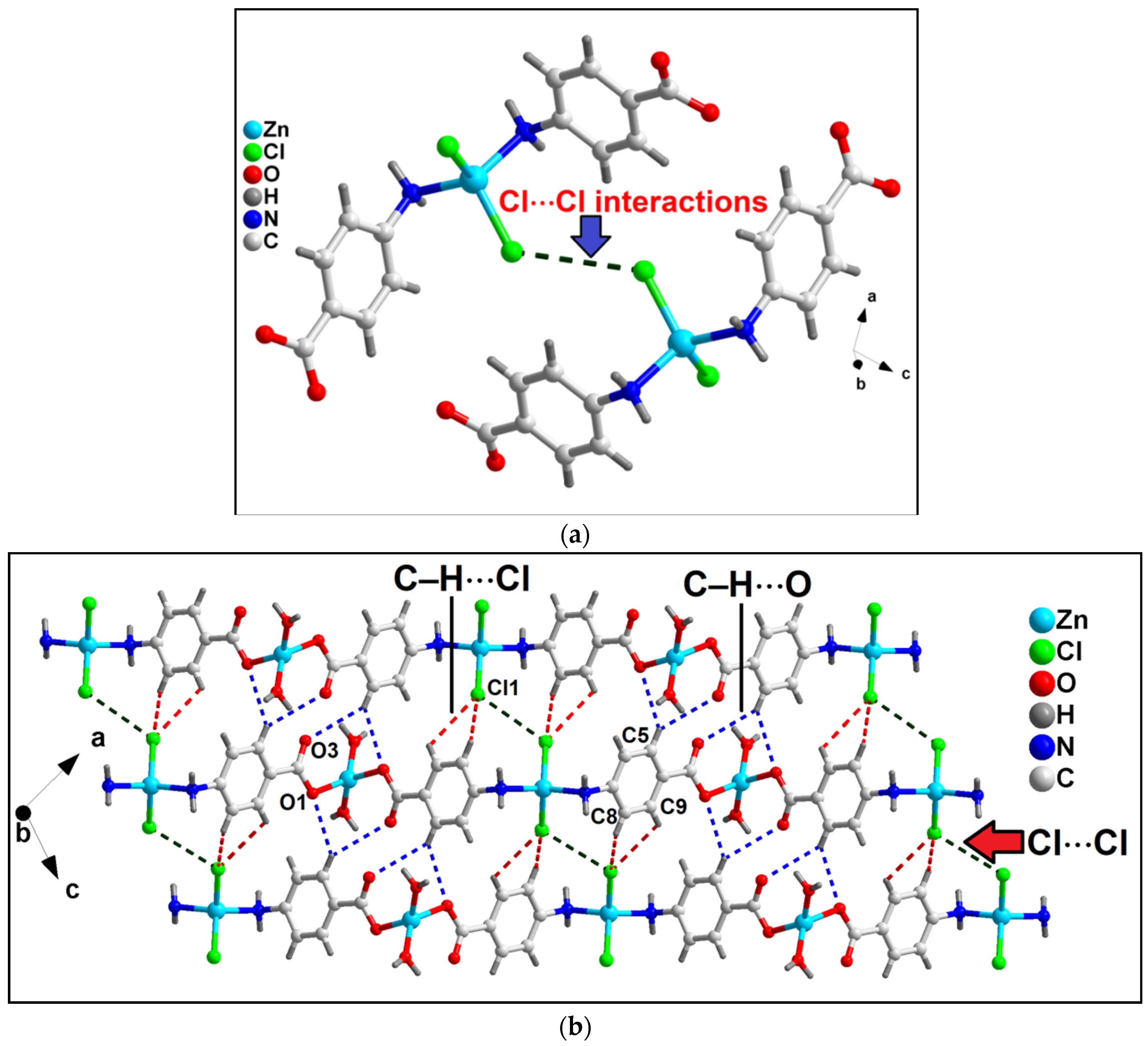


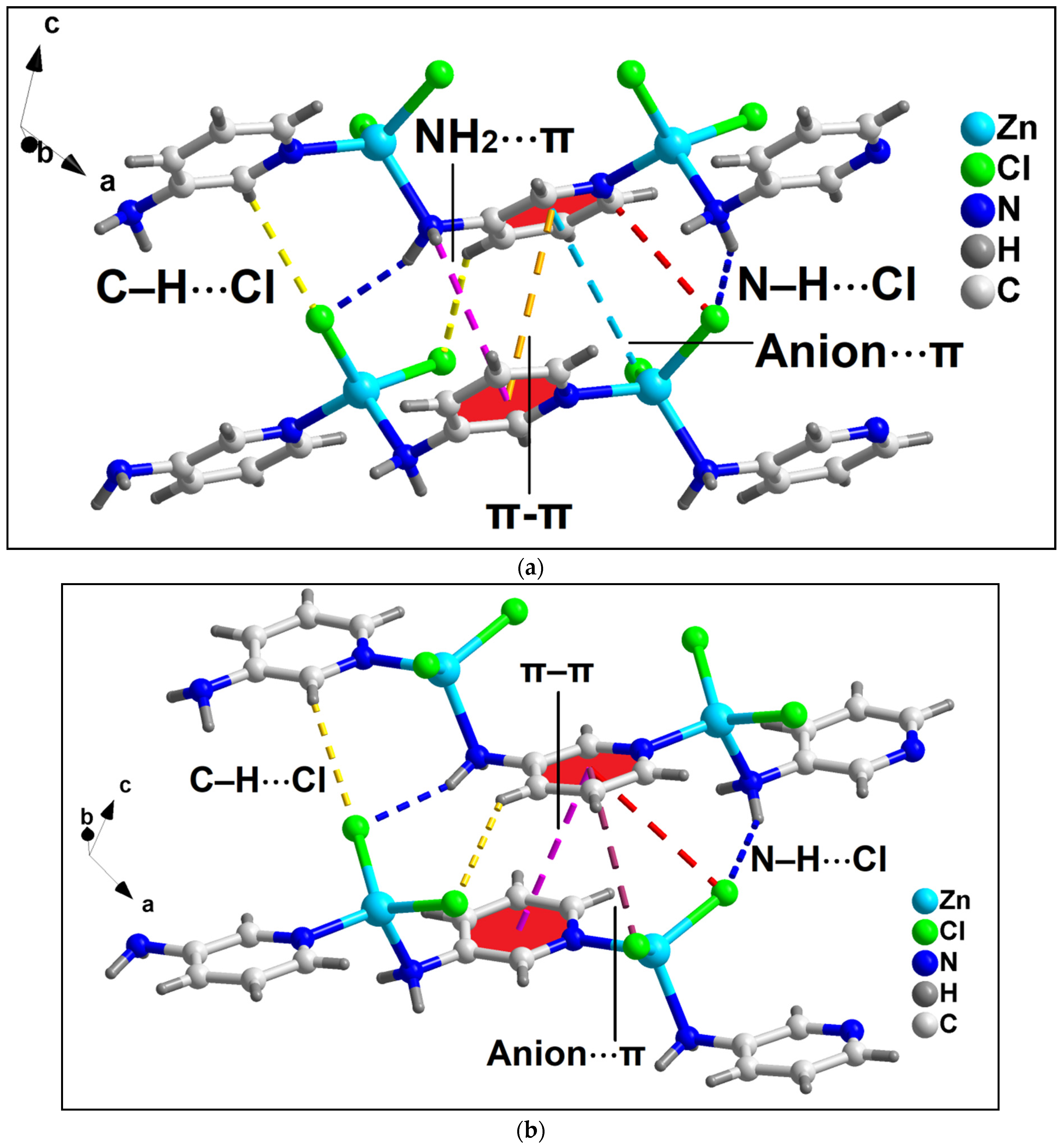
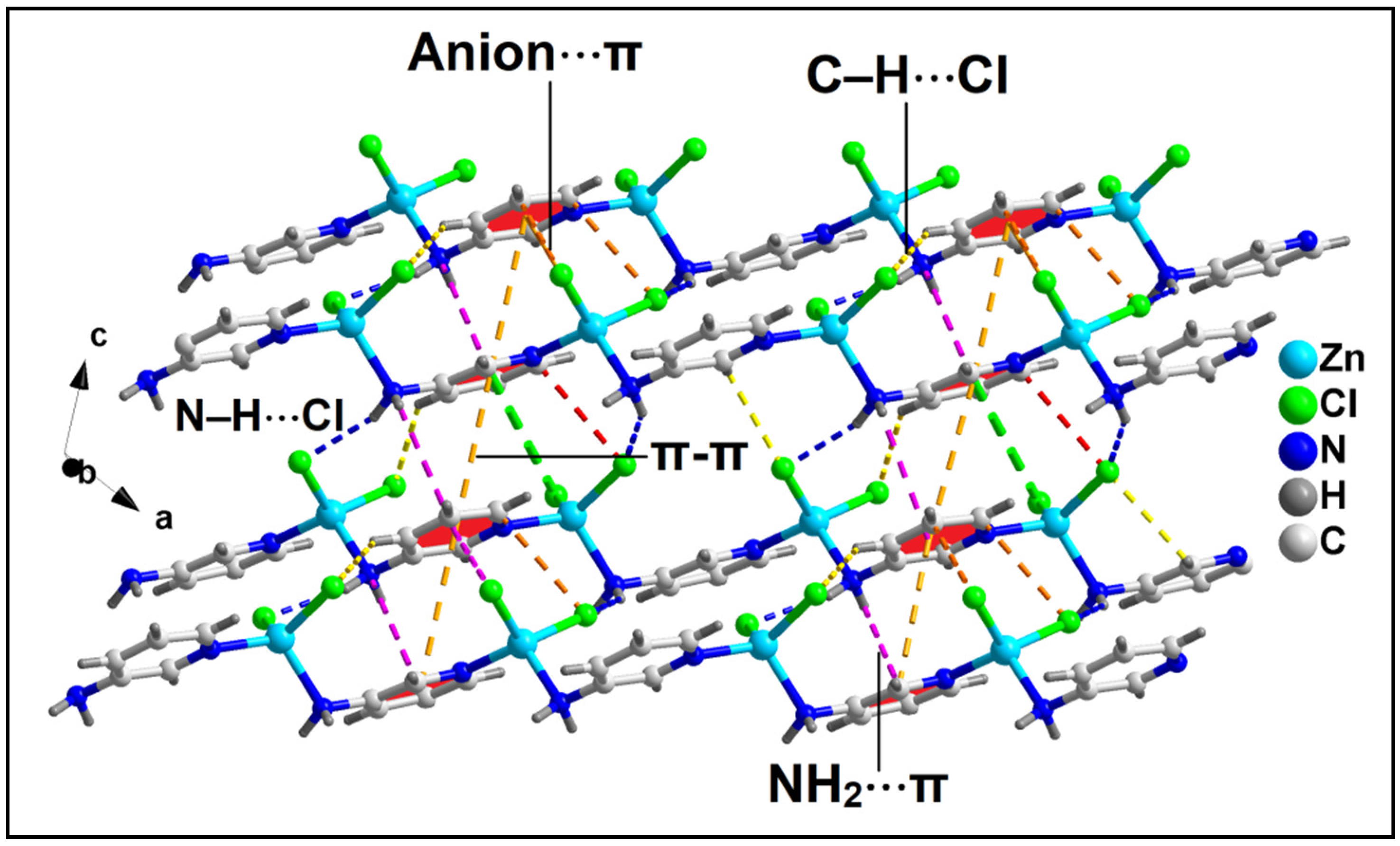
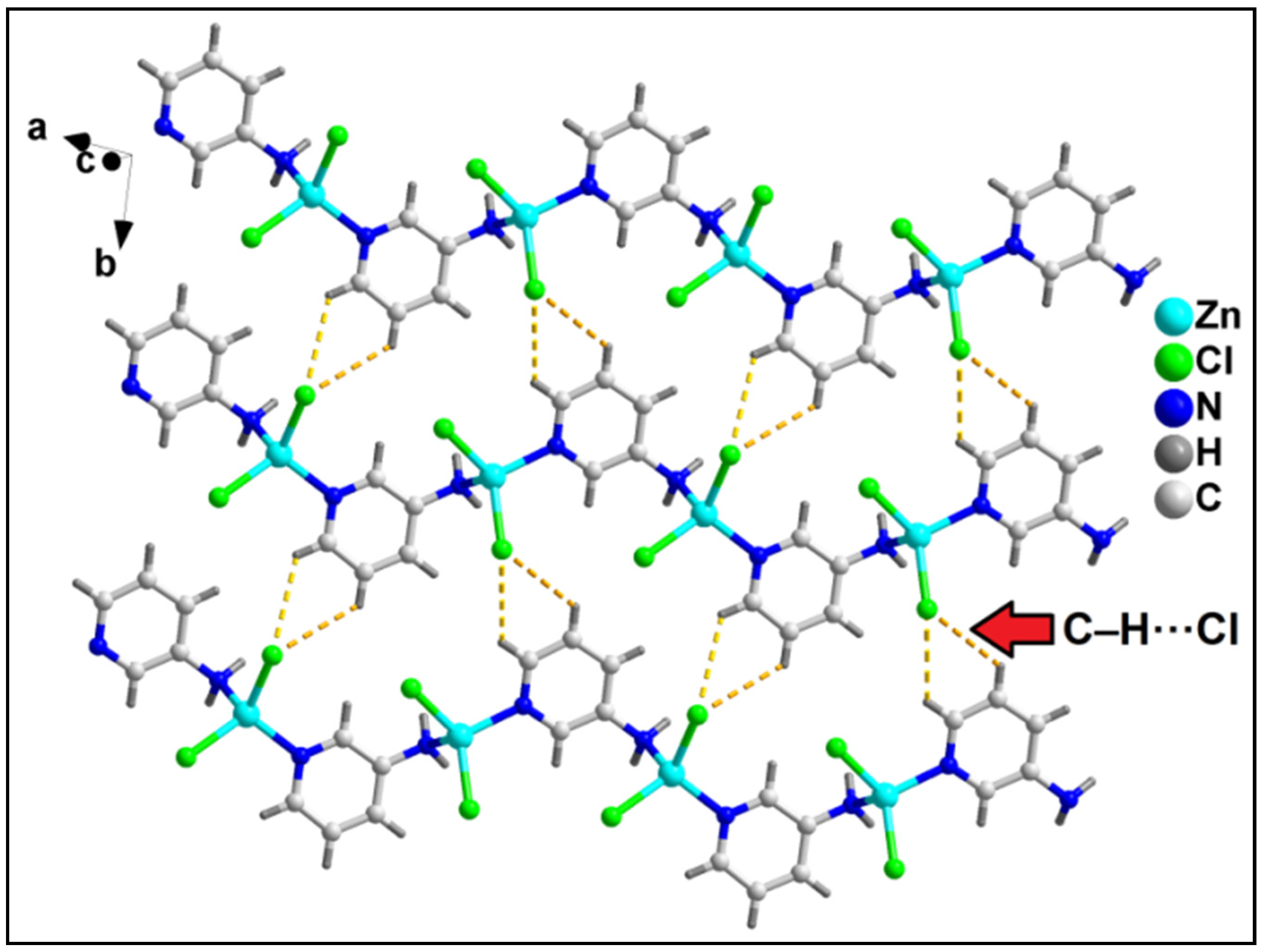

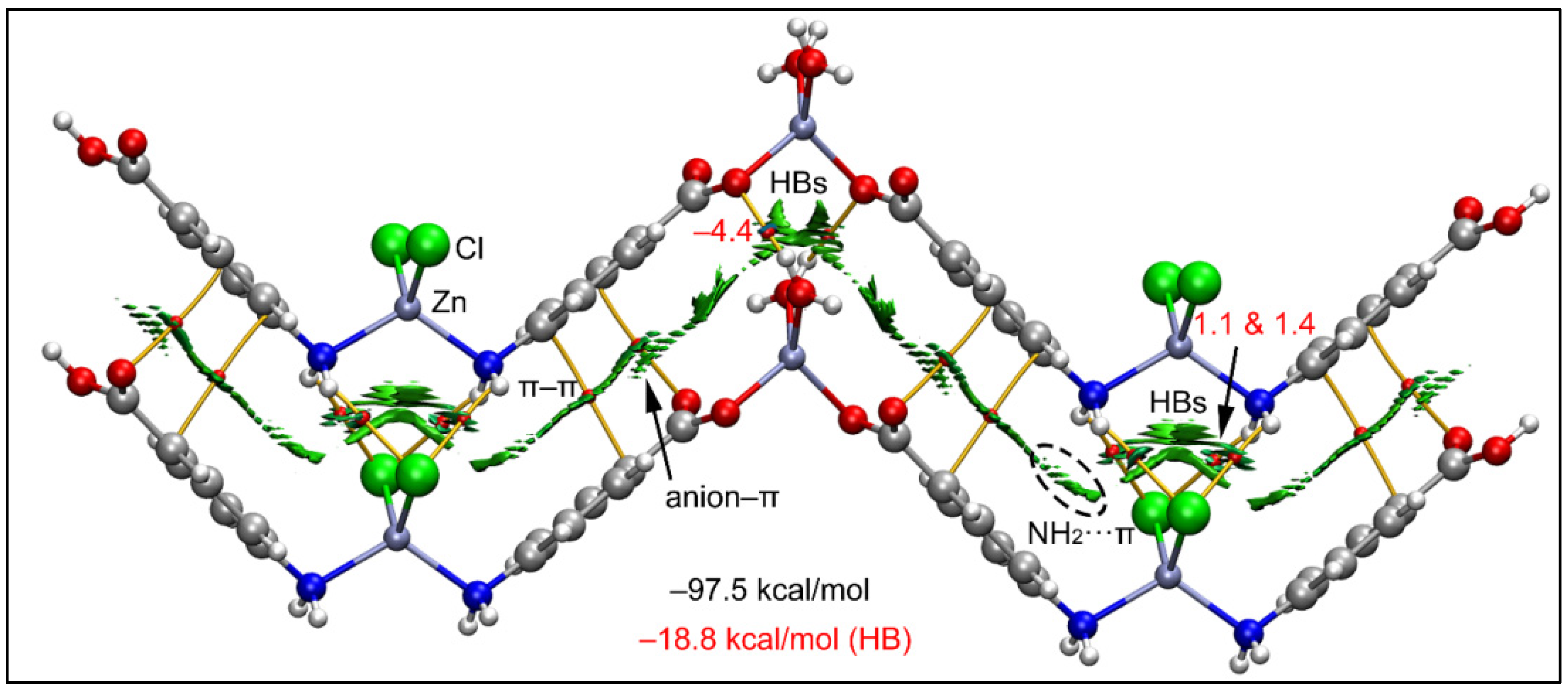
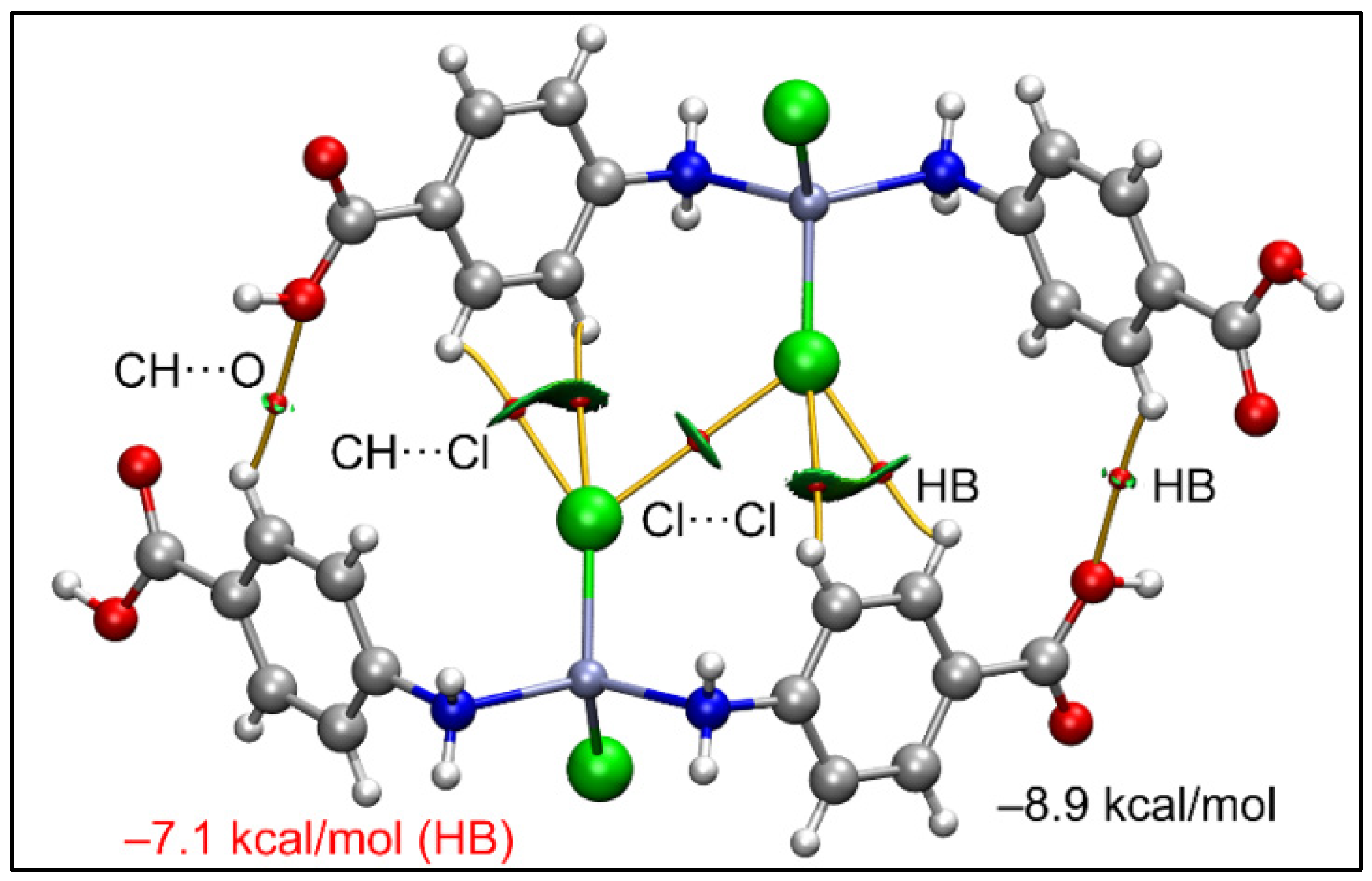
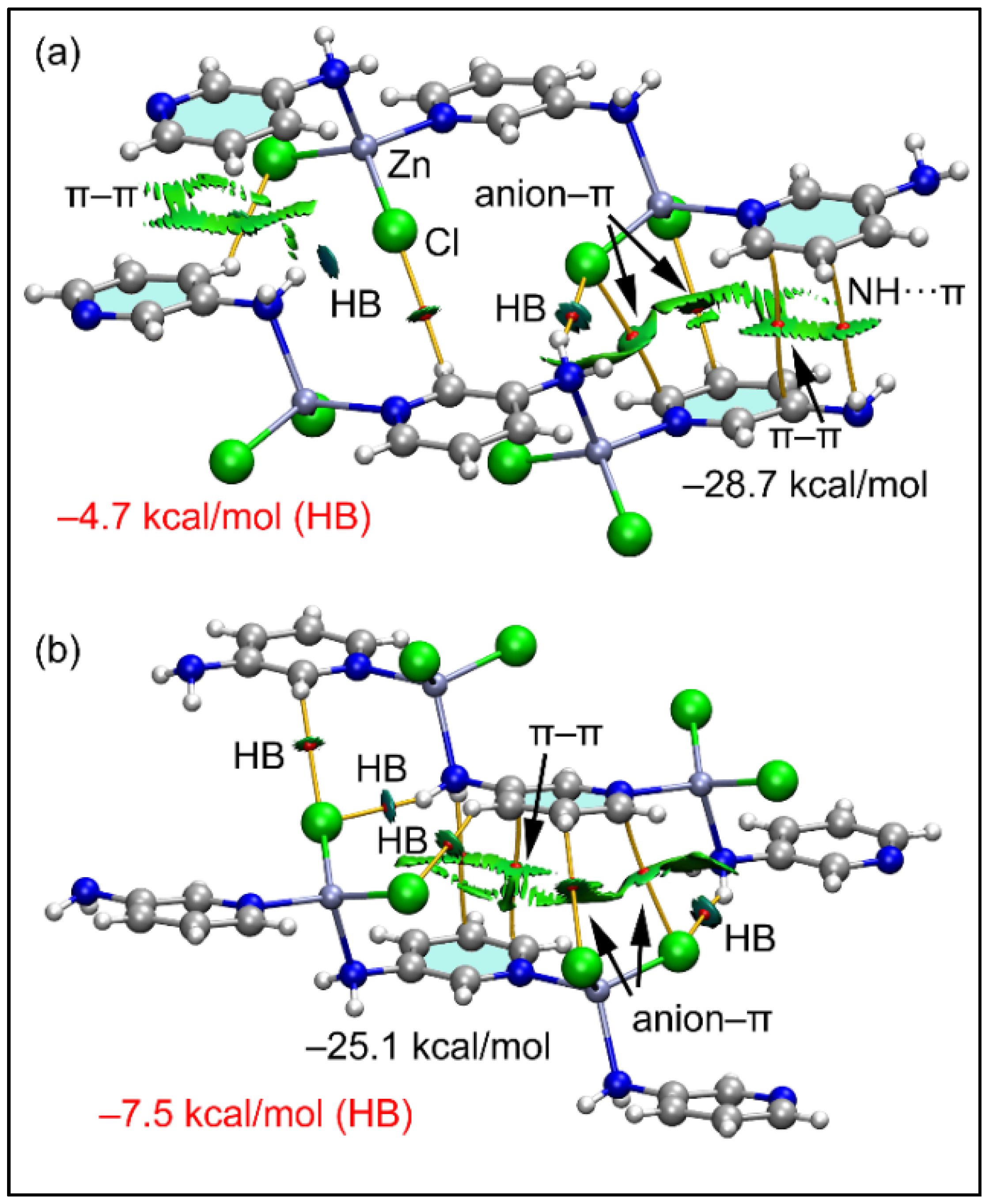

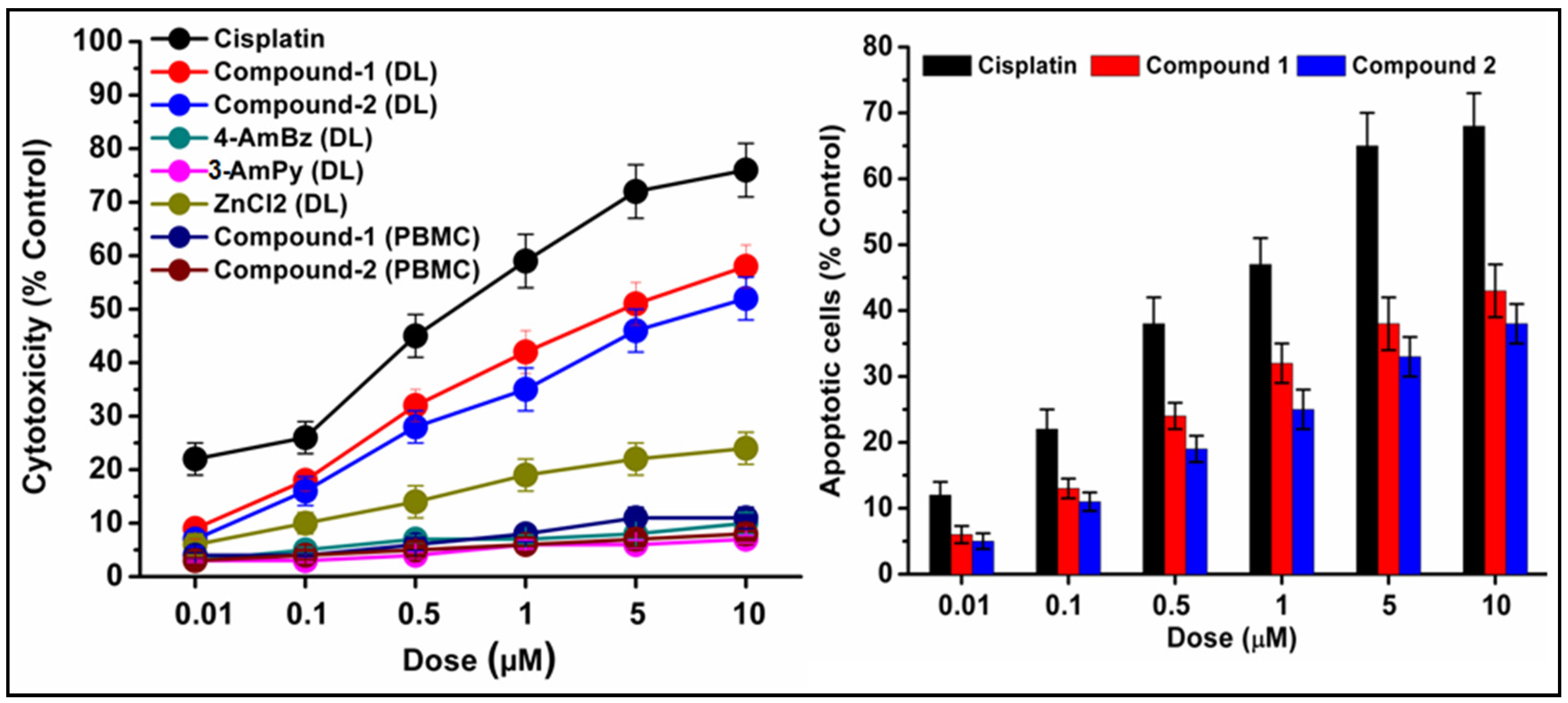
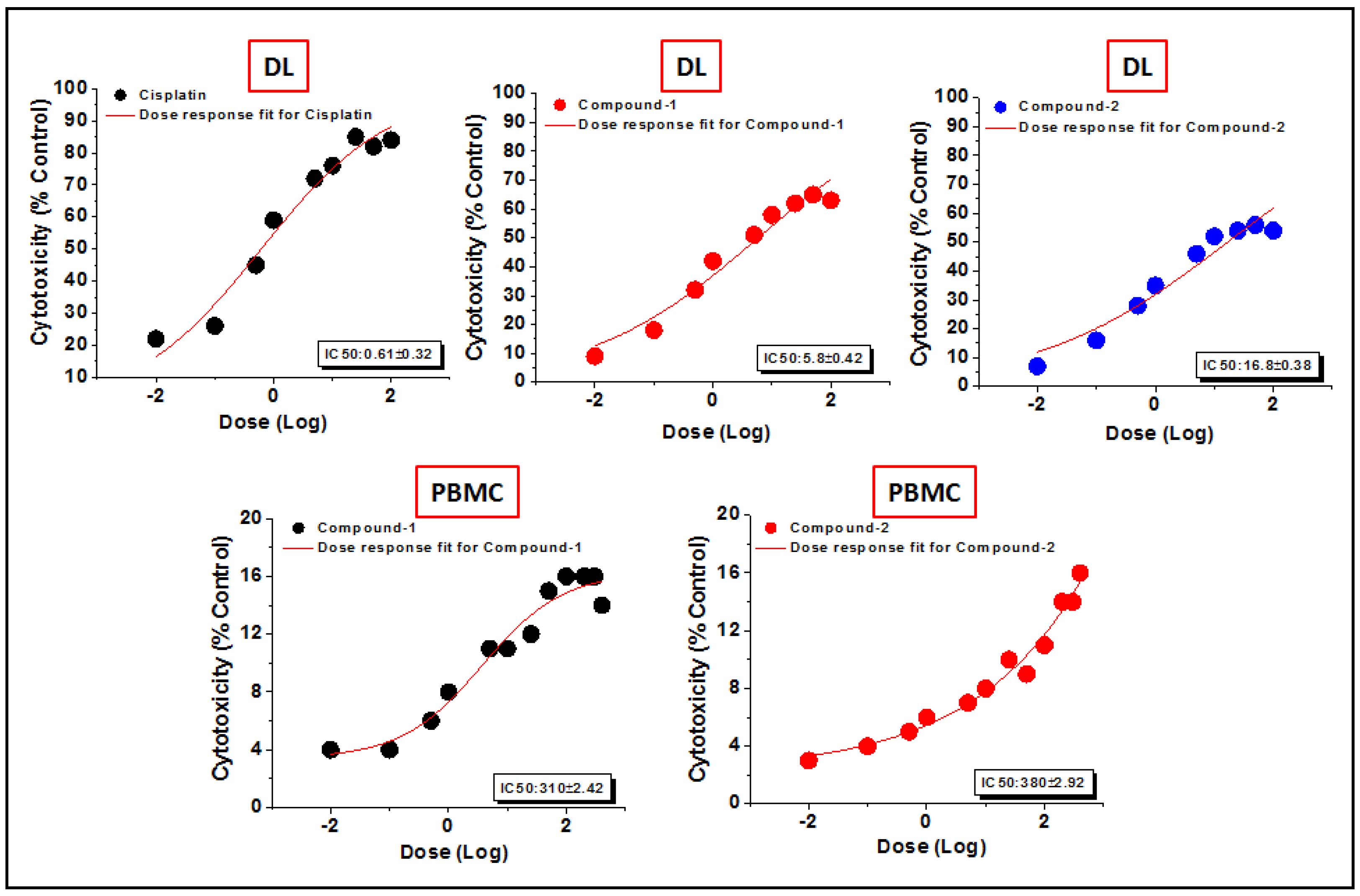
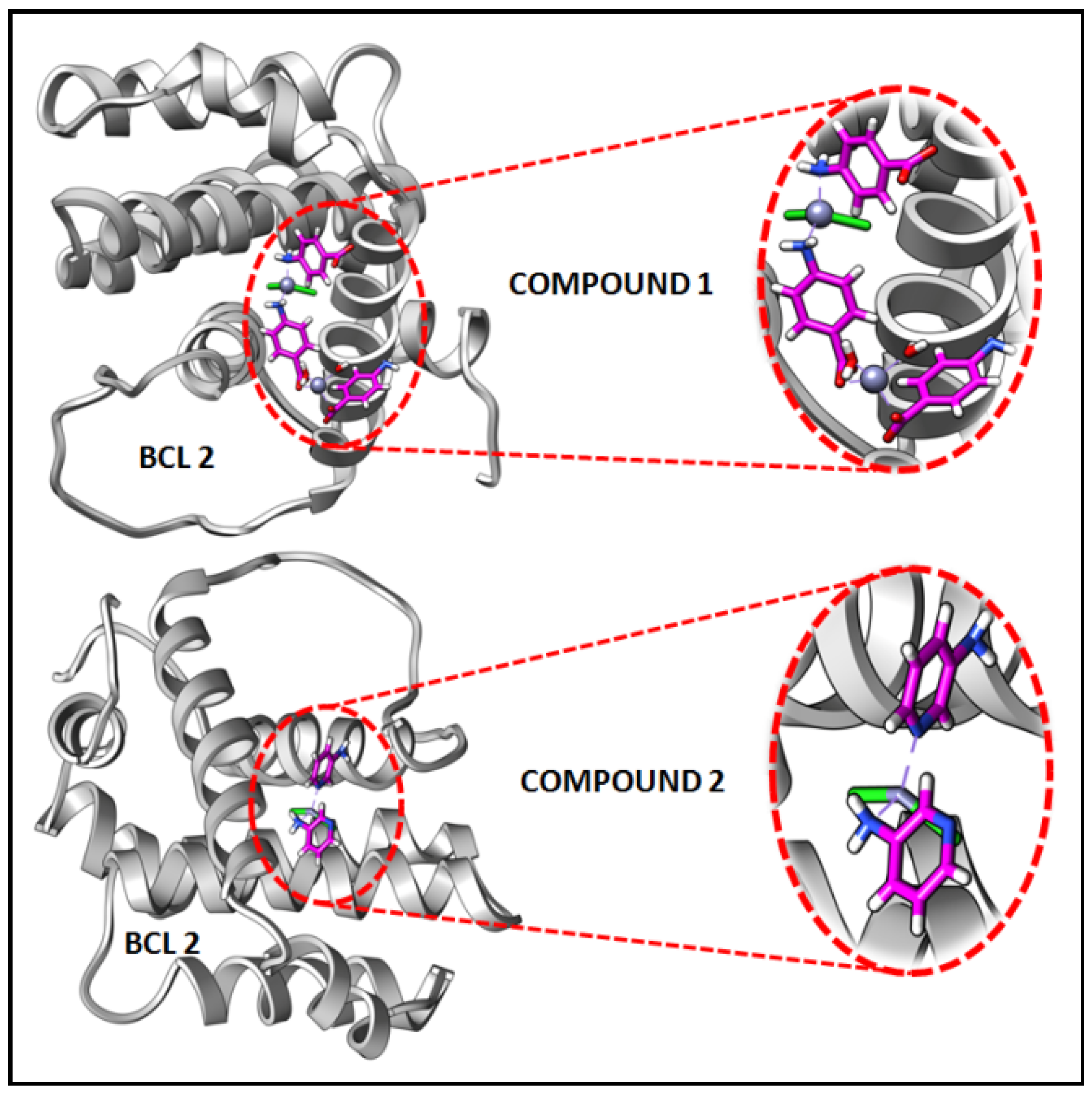
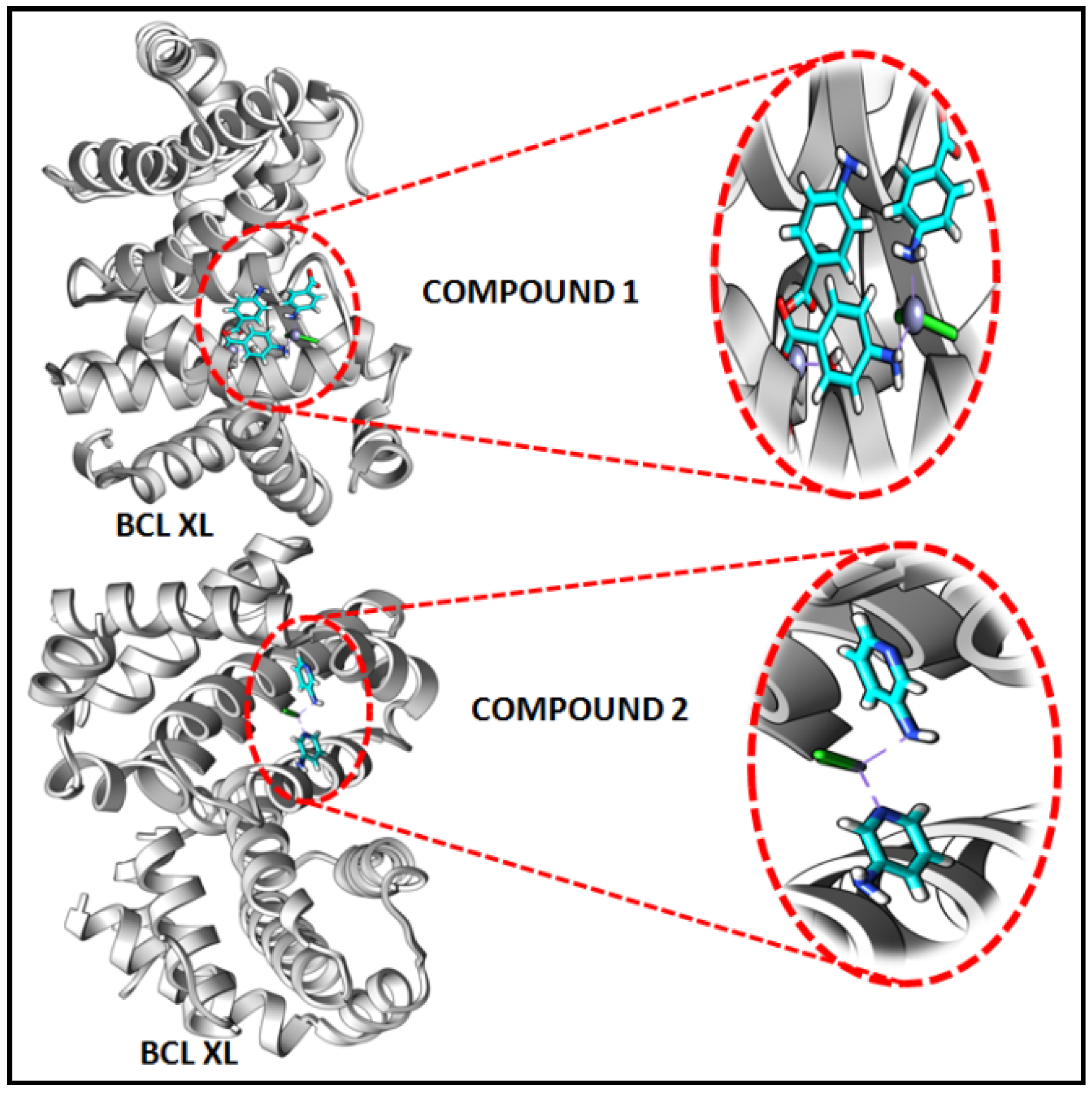

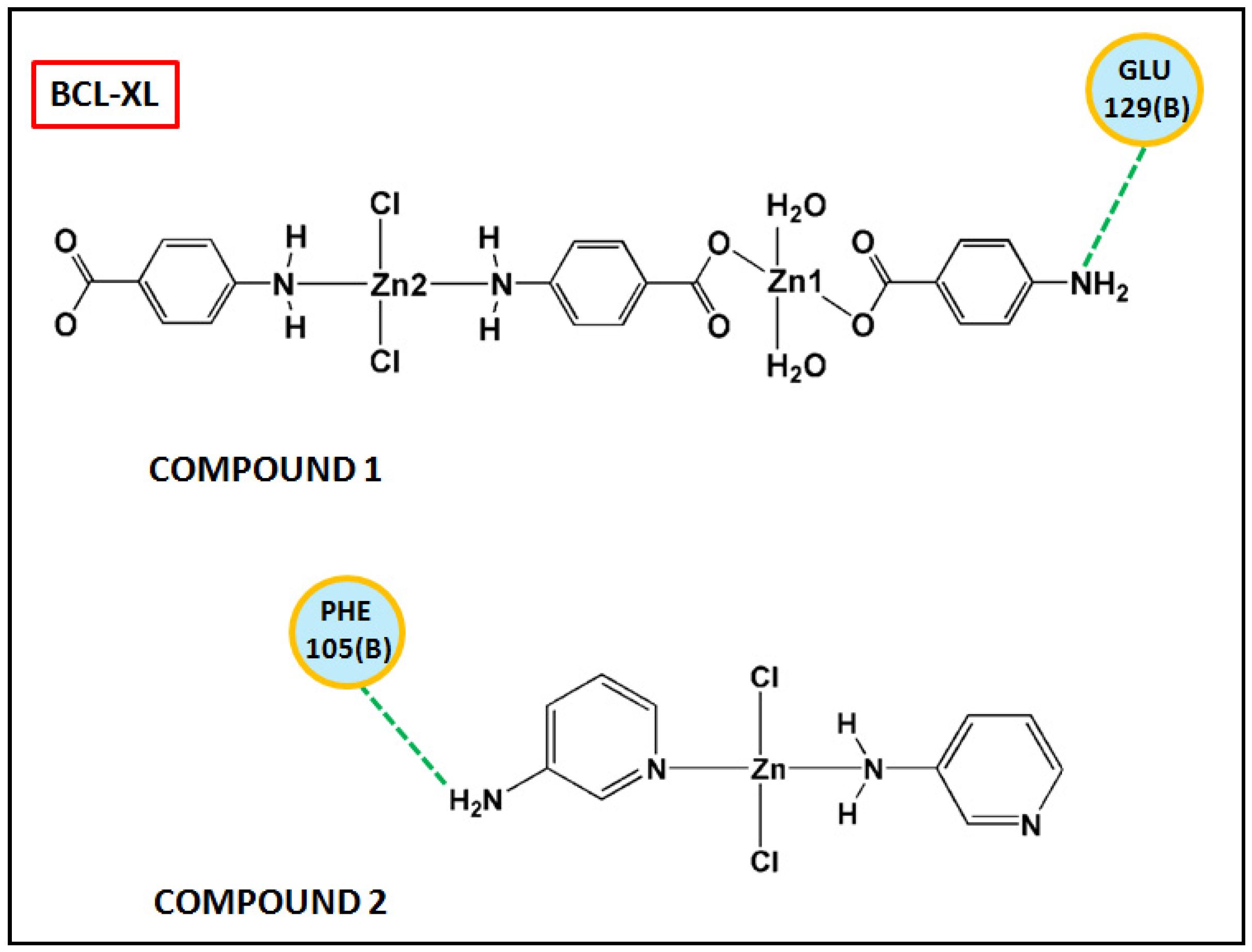
| Parameters | 1 | 2 |
|---|---|---|
| Formula | C14H16N2Zn2O6Cl2 | C5H6Cl2ZnN2 |
| Formula weight | 509.93 | 230.39 |
| Temp, [K] | 294 | 100.0 |
| Crystal system | Monoclinic | Monoclinic |
| Space group | P2/c | Cc |
| a, [Å] | 15.4989(15) | 13.6324(10) |
| b, [Å] | 4.7429(5) | 7.5986(6) |
| c, [Å] | 12.2661(12) | 8.3812(6) |
| α, [°] | 90 | 90 |
| β, [°] | 109.053(3) | 116.926(2) |
| γ, [°] | 90 | 90 |
| V, [Å3] | 851.78(15) | 774.07(10) |
| Z | 2 | 4 |
| Absorption coefficient (mm−1) | 6.692 | 10.113 |
| F(0 0 0) | 512.0 | 456.0 |
| ρcalcg/cm3 | 1.988 | 1.977 |
| index ranges | −18 ≤ h ≤ 18 | −16 ≤ h ≤ 15, |
| −5 ≤ k ≤ 5, | −9 ≤ k ≤9, | |
| −14 ≤ l ≤ 14 | −9 ≤ l ≤ 9 | |
| Crystal size, [mm3] | 0.14 × 0.12 × 0.08 | 0.32× 0.23 × 0.17 |
| 2θ range, [°] | 6.6036 to 137.118 | 13.744 to 133.266 |
| Independent Reflections | 1553 | 1330 |
| Reflections collected | 18,241 | 4757 |
| Refinement method | Full-matrix | Full-matrix |
| least-squares on F2 | least-squares on F2 | |
| Data/restraints/parameters | 1553/0/120 | 1330/2/93 |
| Goodness-of-fit on F2 | 1.236 | 1.072 |
| Final R indices [I > 2σ(I)] indices (all data) | R1 = 0.0554, wR2 = 0.1645 R1 = 0.0554, wR2 = 0.1645 | R1 = 0.0282, wR2 = 0.0729 R1 = 0.0282, wR2 = 0.0729 |
| Largest hole and peak [e·Å−3] | 1.22/−0.76 | 0.62/−0.67 |
| Bond | d (Å) | Angle | Degree (°) |
|---|---|---|---|
| 1 | |||
| Zn1–O1 | 1.977(5) | O1–Zn1–O1W | 98.03(22) |
| Zn1–O1W | 1.966(6) | O1–Zn1–O1 | 103.55(20) |
| Zn2–N10 | 2.067(6) | O1–Zn1–O1W | 133.00(22) |
| Zn2–Cl1 | 2.242(2) | O1W–Zn1–O1W | 96.79(23) |
| O1–Zn1–O1W | 98.03(22) | ||
| N10–Zn2–Cl1 | 107.82(17) | ||
| N10–Zn2–N10 | 114.96(24) | ||
| N10–Zn2–Cl1 | 108.12(18) | ||
| Cl1–Zn2–Cl1 | 109.95(67) | ||
| N10–Zn2–Cl1 | 107.82(17) | ||
| 2 | |||
| Zn1–Cl1 | 2.231(1) | Cl1–Zn1–Cl2 | 119.89(50) |
| Zn1–Cl2 | 2.236(1) | Cl1–Zn1–N1 | 109.68(14) |
| Zn1–N1 | 2.025(4) | Cl1–Zn1–N3 | 102.42(12) |
| Zn1–N3 | 2.087(6) | Cl2–Zn1–N1 | 109.37(14) |
| Cl2–Zn1–N3 | 103.06(13) | ||
| N1–Zn1–N3 | 112.01(21) |
| D–H⋯A | d(D–H) | d(H⋯A) | d(D–A) | <(DHA) |
|---|---|---|---|---|
| Compound 1 | ||||
| C5–H5⋯O3 | 0.95 | 2.63 | 2.903(9) | 96.4 |
| C9–H9⋯O1 | 0.95 | 2.46 | 2.777(8) | 98.8 |
| C5–H5⋯O1 | 0.95 | 2.73 | 3.505(1) | 138.9 |
| C5–H5⋯O3 | 0.95 | 2.81 | 3.628(9) | 140.9 |
| C6–H6⋯N10 | 0.95 | 2.63 | 2.458(1) | 68.8 |
| C8–H8⋯N10 | 0.95 | 2.60 | 2.438(9) | 69.3 |
| O1W–H1WA⋯O3#1 | 0.87 | 2.63 | 3.091(7) | 114.0 |
| O1W–H1WB⋯O1#2 | 0.87 | 2.10 | 2.714(7) | 126.2 |
| Compound 2 | ||||
| C2–H2⋯N3 | 0.95 | 2.60 | 2.445(6) | 69.9 |
| C4–H4⋯N3 | 0.95 | 2.64 | 2.455(6) | 68.2 |
| C6–H6⋯Cl1 | 0.95 | 3.00 | 3.591(4) | 121.5 |
| C6–H6⋯Cl2 | 0.95 | 3.03 | 3.693(5) | 127.5 |
| C4–H4⋯Cl1 | 0.95 | 2.82 | 3.598(5) | 139.5 |
Disclaimer/Publisher’s Note: The statements, opinions and data contained in all publications are solely those of the individual author(s) and contributor(s) and not of MDPI and/or the editor(s). MDPI and/or the editor(s) disclaim responsibility for any injury to people or property resulting from any ideas, methods, instructions or products referred to in the content. |
© 2023 by the authors. Licensee MDPI, Basel, Switzerland. This article is an open access article distributed under the terms and conditions of the Creative Commons Attribution (CC BY) license (https://creativecommons.org/licenses/by/4.0/).
Share and Cite
Sharma, P.; Gomila, R.M.; Barceló-Oliver, M.; Verma, A.K.; Dutta, D.; Frontera, A.; Bhattacharyya, M.K. Unconventional Dual Donor-Acceptor Topologies of Aromatic Rings in Amine-Based Polymeric Tetrahedral Zn(II) Compounds Involving Unusual Non-Covalent Contacts: Antiproliferative Evaluation and Theoretical Studies. Crystals 2023, 13, 382. https://doi.org/10.3390/cryst13030382
Sharma P, Gomila RM, Barceló-Oliver M, Verma AK, Dutta D, Frontera A, Bhattacharyya MK. Unconventional Dual Donor-Acceptor Topologies of Aromatic Rings in Amine-Based Polymeric Tetrahedral Zn(II) Compounds Involving Unusual Non-Covalent Contacts: Antiproliferative Evaluation and Theoretical Studies. Crystals. 2023; 13(3):382. https://doi.org/10.3390/cryst13030382
Chicago/Turabian StyleSharma, Pranay, Rosa M. Gomila, Miquel Barceló-Oliver, Akalesh K. Verma, Diksha Dutta, Antonio Frontera, and Manjit K. Bhattacharyya. 2023. "Unconventional Dual Donor-Acceptor Topologies of Aromatic Rings in Amine-Based Polymeric Tetrahedral Zn(II) Compounds Involving Unusual Non-Covalent Contacts: Antiproliferative Evaluation and Theoretical Studies" Crystals 13, no. 3: 382. https://doi.org/10.3390/cryst13030382
APA StyleSharma, P., Gomila, R. M., Barceló-Oliver, M., Verma, A. K., Dutta, D., Frontera, A., & Bhattacharyya, M. K. (2023). Unconventional Dual Donor-Acceptor Topologies of Aromatic Rings in Amine-Based Polymeric Tetrahedral Zn(II) Compounds Involving Unusual Non-Covalent Contacts: Antiproliferative Evaluation and Theoretical Studies. Crystals, 13(3), 382. https://doi.org/10.3390/cryst13030382








